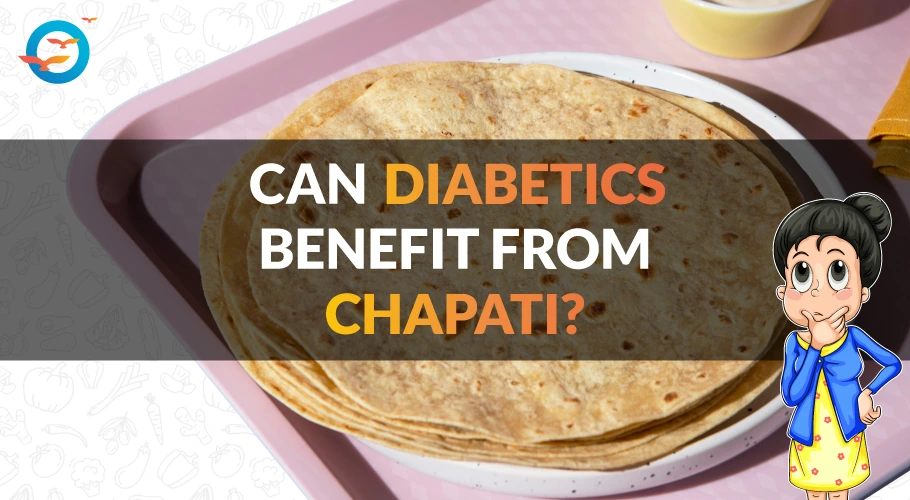Is Wheat Chapati Good for Diabetes?

Wheat chapati for diabetic patient
In this blog, we'll delve into the nutritional aspects of the traditional chapati and explore its impact on blood sugar levels.
Nutrient Composition:
Chapati or roti, an Indian staple is prepared by rolling out small wheat dough balls and cooking them on a hot griddle.
It is a common accompaniment to curries, gravies, and lentil dishes.Traditional flour carries several nutritional benefits.
Whole wheat is rich in fiber, vitamins, and minerals while contributing to better digestion and overall health. Fiber, in particular, plays a crucial role in slowing down the absorption of glucose, helping to manage blood sugar levels.
The Glycemic Index Perspective:
Whole wheat has a lower GI compared to refined grains, which means it has a more gradual impact on blood sugar. This property is beneficial for individuals with diabetes as it helps keep sugars stable.
What is recommended?
Indian organic varieties are preferred.
Why you might ask?
Well, organic varieties are cultivated using natural and sustainable farming methods, avoiding synthetic pesticides and fertilizers.
Organic wheat is often processed less than conventionally grown wheat, preserving more of its natural nutrients.
This can result in higher nutritional value, including essential vitamins, minerals, and antioxidants, contributing to better overall health.
Importance of sticking to a brand
Sticking to a brand is important. This will help ensure a familiar and desirable outcome including the consistency in ingredient choice.
Tips for a Diabetic-Friendly Chapati:
-
Opt for Whole wheat:
Choose whole wheat flour over refined flour. -
Mindful Cooking Techniques:
Use minimal oil and opt for healthier cooking methods like grilling or roasting instead of frying. -
Mindful portions:
While whole wheat chapati can be a part of a diabetes-friendly diet, portion control is key. Two rotis per meal is a standard dietary norm. - Accompany with Low-Glycemic Side dishes Pairing chapatis with fiber-rich vegetables, lean proteins, and healthy fats can further enhance its nutritional profile and help stabilize blood sugar levels.
While one must consider all the above points before making wheat chapati as a choice of food, one must also be informed about gluten sensitivity or gluten allergy.
Wheat naturally contains a protein called as gluten. Some individuals may be allergic to this protein or some may be sensitive for presence of gluten in food. Understanding this fact make choice of including wheat chapati in your diet.
Read more about Best Flour for Diabetes, you can visit this blog.
Conclusion:
In summary, incorporating chapati made from whole wheat flour can be part of a well-rounded diet for individuals managing diabetes.
However, like any dietary choice, moderation and thoughtful decisions are crucial. It is recommended for individuals with diabetes to seek guidance from healthcare professionals or nutritionists for a personalized meal plan aligned with their specific health needs and objectives.
At Freedom from Diabetes, we advocate the 25% formula, comprising 25% dal, 25% vegetables, 25% salads, and 25% grains. This formula has proven effective, with over 15,000 individuals successfully reversing diabetes and becoming medicine-free.
The wheat varieties that we highly recommend are like khapli wheat, Emmer wheat, Durum wheat, Buck wheat etc.
Join our introductory Discover Reversal Session to learn about the process of diabetes reversal. Consider participating in our annual Holistic Transformation Program to embark on your own reversal journey.
FAQs
Is whole wheat chapati safe for diabetics?
Yes, whole wheat chapati can be a good option for diabetics when eaten in moderation due to its low glycemic index.
Can I eat wheat chapati if I have diabetes?
Yes, you can eat wheat chapati in moderation if you have diabetes. Whole wheat chapati has a lower glycemic index compared to refined flour chapati, which can help manage blood sugar levels better. Eat in moderation.
Can whole wheat chapati raise blood sugar levels?
Whole wheat chapati may raise blood sugar, but less than refined flour products like white bread. Pairing it with vegetables and protein helps stabilize blood sugar levels.
How many chapatis can a diabetic eat in a day?
The number of chapatis a diabetic can eat depends on individual needs and overall diet. It's best to consult with a doctor or nutritionist for personalized guidance.
Is whole wheat chapati better than rice for diabetics?
Whole wheat chapati generally has a lower glycemic index than white rice, making it a better choice for controlling blood sugar.
Does chapati help in managing diabetes?
When part of a balanced diet, whole wheat chapati can help manage diabetes by providing slow-releasing carbohydrates and fiber.
Can I eat wheat chapati with other foods like curries or vegetables?
Yes, wheat chapati can be paired with curries, vegetables, or dal for a balanced meal. Opt for low-fat, high-fiber curries and avoid overly rich or creamy dishes to keep your blood sugar levels stable.

